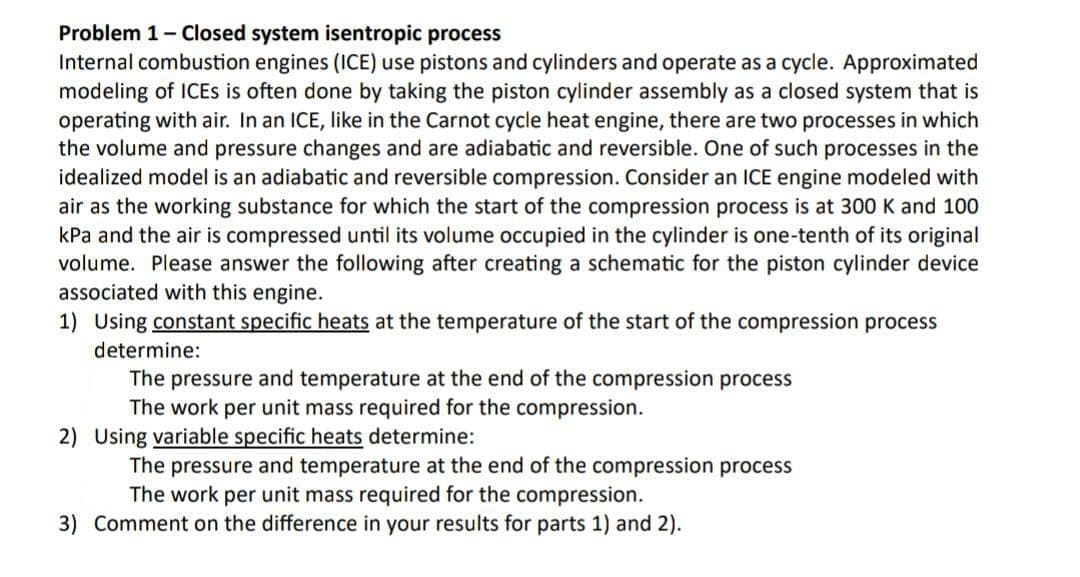Problem 1-Closed system isentropic process Internal combustion engines (ICE) use pistons and cylinders and operate as a cycle. Approximated modeling of ICES is often done by taking the piston cylinder assembly as a closed system that is operating with air. In an ICE, like in the Carnot cycle heat engine, there are two processes in which the volume and pressure changes and are adiabatic and reversible. One of such processes in the idealized model is an adiabatic and reversible compression. Consider an ICE engine modeled with air as the working substance for which the start of the compression process is at 300 K and 100 kPa and the air is compressed until its volume occupied in the cylinder is one-tenth of its original volume. Please answer the following after creating a schematic for the piston cylinder device associated with this engine. 1) Using constant specific heats at the temperature of the start of the compression process determine: The pressure and temperature at the end of the compression process The work per unit mass required for the compression. 2) Using variable specific heats determine: The pressure and temperature at the end of the compression process The work per unit mass required for the compression. 3) Comment on the difference in your results for parts 1) and 2).
Problem 1-Closed system isentropic process Internal combustion engines (ICE) use pistons and cylinders and operate as a cycle. Approximated modeling of ICES is often done by taking the piston cylinder assembly as a closed system that is operating with air. In an ICE, like in the Carnot cycle heat engine, there are two processes in which the volume and pressure changes and are adiabatic and reversible. One of such processes in the idealized model is an adiabatic and reversible compression. Consider an ICE engine modeled with air as the working substance for which the start of the compression process is at 300 K and 100 kPa and the air is compressed until its volume occupied in the cylinder is one-tenth of its original volume. Please answer the following after creating a schematic for the piston cylinder device associated with this engine. 1) Using constant specific heats at the temperature of the start of the compression process determine: The pressure and temperature at the end of the compression process The work per unit mass required for the compression. 2) Using variable specific heats determine: The pressure and temperature at the end of the compression process The work per unit mass required for the compression. 3) Comment on the difference in your results for parts 1) and 2).
Refrigeration and Air Conditioning Technology (MindTap Course List)
8th Edition
ISBN:9781305578296
Author:John Tomczyk, Eugene Silberstein, Bill Whitman, Bill Johnson
Publisher:John Tomczyk, Eugene Silberstein, Bill Whitman, Bill Johnson
Chapter45: Domestic Refrigerators And Freezers
Section: Chapter Questions
Problem 12RQ: Refrigerators currently being manufactured in the United States are using______as their refrigerant.
Related questions
Question
Dont ignore solve for me All ok take ur time

Transcribed Image Text:Problem 1 - Closed system isentropic process
Internal combustion engines (ICE) use pistons and cylinders and operate as a cycle. Approximated
modeling of ICEs is often done by taking the piston cylinder assembly as a closed system that is
operating with air. In an ICE, like in the Carnot cycle heat engine, there are two processes in which
the volume and pressure changes and are adiabatic and reversible. One of such processes in the
idealized model is an adiabatic and reversible compression. Consider an ICE engine modeled with
air as the working substance for which the start of the compression process is at 300 K and 100
kPa and the air is compressed until its volume occupied in the cylinder is one-tenth of its original
volume. Please answer the following after creating a schematic for the piston cylinder device
associated with this engine.
1) Using constant specific heats at the temperature of the start of the compression process
determine:
The pressure and temperature at the end of the compression process
The work per unit mass required for the compression.
2) Using variable specific heats determine:
The pressure and temperature at the end of the compression process
The work per unit mass required for the compression.
3) Comment on the difference in your results for parts 1) and 2).
Expert Solution
This question has been solved!
Explore an expertly crafted, step-by-step solution for a thorough understanding of key concepts.
This is a popular solution!
Trending now
This is a popular solution!
Step by step
Solved in 3 steps with 2 images

Knowledge Booster
Learn more about
Need a deep-dive on the concept behind this application? Look no further. Learn more about this topic, mechanical-engineering and related others by exploring similar questions and additional content below.Recommended textbooks for you

Refrigeration and Air Conditioning Technology (Mi…
Mechanical Engineering
ISBN:
9781305578296
Author:
John Tomczyk, Eugene Silberstein, Bill Whitman, Bill Johnson
Publisher:
Cengage Learning

Refrigeration and Air Conditioning Technology (Mi…
Mechanical Engineering
ISBN:
9781305578296
Author:
John Tomczyk, Eugene Silberstein, Bill Whitman, Bill Johnson
Publisher:
Cengage Learning